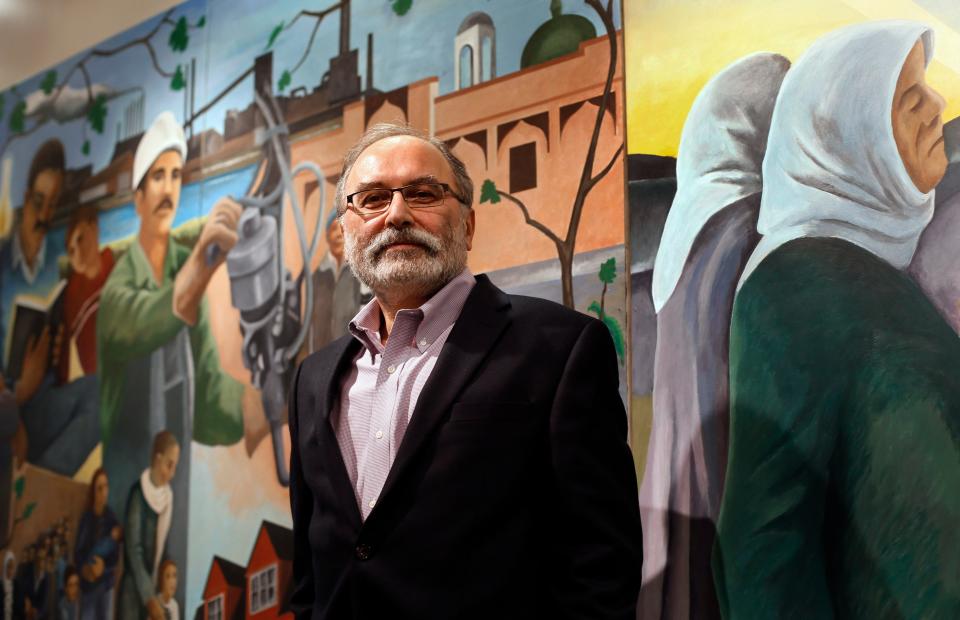Arab Americans, tired of being invisible in federal data, demand to identify as MENA, not white
Many Middle Eastern and North African Americans are hopeful they will finally be recognized by the federal government, including in the U.S. Census, after years of their community largely being ignored in official data.
The U.S. Office of Management and Budget is working to overhaul how agencies collect data about Americans, a move that many say could result in a new category for people of Middle Eastern or North African background. Arab Americans have long fought to persuade government officials to adopt the racial category, referred to as MENA, as part of standard practice.
"It is instrumental that we recognize MENA communities and address the compounded systemic inequities that we have historically faced and continue to face," said Salma Mohamed, partnership and capacity-building specialist for the Arab-American Family Support Center in New York City. "There is a systemic inequality that renders our voices often invisible."
In June, the Office of Management and Budget announced it would review Statistical Policy Directive Number 15, which establishes the minimum categories for all federal agencies conducting data collection on race and ethnicity. While the agency's fully revised standards aren’t expected until 2024, the office will launch a series of public comment sessions to help shape the new standards starting next week.

Karin Orvis, the nation's chief statistician, noted that much has changed since the standards were last updated 25 years ago.
"Directive No. 15 provides minimum standards that ensure our ability to compare information and data across federal agencies, and also to understand how well federal programs serve a diverse America," Orvis wrote in a blog post announcing the revision process. "Ultimately, this (review) will help ensure the standards better reflect the diversity of the American people."
As part of that broader undertaking, the office updated its best practices and outlined ways to collect more detailed demographic data, including a footnote in which it described a sample question with which agencies could ask about Middle Eastern and North African ancestry.
Advocates said the fact that the agency singled out the MENA community early on in the process is a hopeful sign.
“It’s a big deal,” said Ryan Costello, policy director for the National Iranian American Council, based in Washington, D.C. “These communities are vital to the fabric of the United States, but the Census and many federal programs have repeatedly failed to recognize them.”
US officially classifies Arab Americans as 'white'
For decades, the nation’s estimated 3.7 million Arab Americans have been unable to self-identify as such on the census and other government forms, instead officially classified as “white.” The OMB's 1997 standards, which the Census and other agencies follow, define white as "a person having origins in any of the original peoples of Europe, the Middle East, or North Africa."
Among the challenges posed by the situation is a lack of health data that, for instance, cloaked the COVID pandemic’s effects on the nation's Arab communities despite numerous risk factors.
Arab American communities are also denied access to federal funding programs such as those supporting community development or public health and education efforts for marginalized people. Additionally, they are left out when authorities track issues such as employment discrimination or infant mortality rates.
Mohamed, of New York's Arab-American Family Support Center, said she has seen such inequities play out in housing, food security, domestic violence and hate crimes.
"All of these nuances and how they affect MENA communities is not understood on a mainstream level," she said.
Maha Freij, president and CEO of the Arab Community Center for Economic and Social Services, a social service agency known as ACCESS and based in Dearborn, Michigan, said MENA individuals have been perpetually ignored and denied access to resources "for as long as the U.S. has collected demographic data."
"The new standards move us one step closer to getting the recognition and support our communities deserve,” Freij said in a statement.
While federal agencies are not yet required to collect such data, some have already taken the initiative. Earlier this year, the U.S. Agency for International Development became the first federal agency to put a Middle Eastern/North African category into practice, including it as part of its internal employee survey.
Meanwhile, the Treasury Department added a Middle Eastern/North African ancestry question as part of reporting requirements under its State Small Business Credit Initiative, making it likelier that those communities can access federal assistance earmarked for under-resourced communities.
“That was a huge signal, that a major federal agency was willing to do the work,” said Matthew Stiffler, research and content manager for the Arab American National Museum in Dearborn. “I think it created a snowball effect for where we’re at now.”
For Arab Americans, COVID's effects were 'lost in the mix'
Health administrators at ACCESS have seen the harm caused by not having such data. Madiha Tariq, deputy director of the agency’s Community Health and Research Center, said the lack of Arab COVID infection rates instilled people with a false sense of security as the pandemic progressed.
“People weren’t thinking that COVID was something that was impacting them,” she said.
A 2022 study of data in the Michigan Disease Surveillance System and the American Community Survey found that Arab Americans were more than two and a half times as likely to test positive for COVID-19 than non-Hispanic whites.
With few Michigan state agencies offering MENA individuals a way to self-identify, ACCESS was forced during the pandemic to try to compile such information on its own.
“People were just putting themselves down as white, so the data was getting lost in the mix,” Tariq said. “Especially at a time when public health is so politicized, data plays a big role in convincing the community that an issue needs to be prioritized. You can actually make the case, that this many people in your community are being affected.”
For those suffering from a public health crisis, such recognition can be affirming at a crucial time.
"Community health issues become much worse when you feel that you’re alone in them," Tariq said. "It’s like, ‘What I’m going through is just a small piece of this big picture.’ And it helps us be better health providers.”

Stiffler, who has helped ACCESS in its efforts to collect better data on the Arab American community, said the ability to self-identity is also essential when Arab Americans have been subjected to post-9/11 law enforcement surveillance or subject to hateful rhetoric over events occurring a half-world away.
“You’re being called out for your identity, but you’re also not able to assert that identity in any official capacity,” Stiffler said. “When a community doesn’t show up in the data, it’s really hard to advocate for that community. It’s really just a matter of being seen.”
Stiffler said he hopes OMB’s new guidelines prove meaningful, with MENA data collection ultimately mandated across all federal agencies.
“That’s the ultimate goal,” he said. “Once that happens, that’s a real game-changer. We’ll take being a footnote for now, but we’re going to keep pushing.”
This article originally appeared on USA TODAY: Arab Americans hope to be counted as feds revise data collection rules

